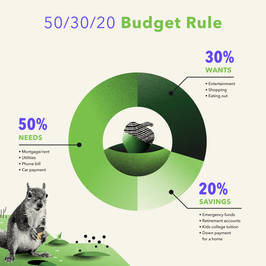How Much of Your Paycheck Should You Save?

Tucking away money may not sound exciting, but it’s one of the best things you can do to prepare for your future and protect your finances from emergencies.
So how much of your paycheck should you save? While everyone’s situation is different, a general rule of thumb is to set aside 20% of your paycheck for savings.
4 common savings goals that you should consider
Before you can figure out how much you should save, decide what you’re saving for. Here are some common financial goals to consider:
Retirement
The earlier you start saving for retirement, the better. According to Fidelity, a good rule of thumb is to have 10 times your salary saved by the time you reach the age of 67. For example, if your salary is $50,000, you’ll need at least $500,000 by the time you’re 67 in retirement accounts. But everyone’s situations — and needs — are different. An online calculator can help you make an estimate.
Emergency fund
It’s inevitable: an emergency — like a car repair or unexpected medical bill — will pop up and derail your plans. In fact, in 2021 the Federal Reserve reported that 20% of adults had major, unexpected medical expenses in the previous 12 months, with a median cost between $1,000 and $1,999.
Having money saved in an emergency fund can help you cover those costs without falling behind on other bills or going into debt. And if you typically live paycheck to paycheck, establishing savings can help end that cycle.
While there is some debate on how much money you need to save in an emergency fund, experts generally recommend saving enough cash to cover 3 to 6 months of expenses.
Big purchases
Whether you want to save a down payment for a house, take a cruise, help your child pay for college, or buy a new vehicle, setting aside a portion of every paycheck can help you make that goal a reality.
Investing
Besides saving money for retirement, investing is another way to plan for your financial future. Although there is the risk of market fluctuations, investing in the stock market can be a great way to grow your money over time. Past performance doesn’t guarantee future results, but history has shown that over time, your money is likely to grow at a higher rate than if you only put money in savings accounts.
Unlike retirement savings accounts, you can access money invested in a taxable brokerage account at any age without incurring penalties.
How much of your paycheck should you save for each goal?
There are many schools of thought on how to divvy up your savings, but one of the most popular is the 50/30/20 rule. This rule suggests that you break down your savings as follows:
-
50% of your paycheck goes toward essentials, such as rent, utilities, groceries, transportation, and required debt payments.
-
30% of your paycheck goes toward wants or non-essential expenses, such as streaming subscriptions, your gym membership, or the occasional dinner out.
-
20% of your paycheck is set aside for your future goals, such as your emergency fund, retirement accounts, or a down payment on a house.
How much of your paycheck should you save for each item within that 20% category? Experts recommend saving 10% to 15% of your income for retirement. But that number can include an employer match if you have one. The remaining 5% to 10% of your paycheck can be split between your emergency fund and other goals.
For example, let’s say your monthly take-home pay — meaning your income after taxes — is $4,000 per month. Here’s how that breaks down, following the 50/30/20 rule:
-
$2,000 covers your essentials
-
$1,200 goes toward wants
-
$800 goes toward your savings
Of that $800, you might set aside $400 — 10% of your monthly income — for retirement. With the remaining $400, you might put $200 in an emergency fund and invest the other $200 for your long-term goals.
Where should you put your savings?
Ready to start saving? Then it's time to think about where to stash your money. When deciding where to put it, think about when you’ll likely need to access it and how comfortable you are with risk. Those factors will affect which account type is best. Popular options include:
-
Checking account: A checking account is often a good choice for the money you need to access to cover bills or upcoming expenses. Checking accounts tend to have very low annual percentage yields (APYs), so your money won’t earn much in interest, but you can quickly and easily access the cash in the account.
-
Savings account: Savings accounts are a good option for saving for future, short-term goals, or when you can’t risk losing any money. For example, a savings account can be a smart choice for your emergency fund or to set aside money for a down payment. Savings accounts can earn interest.
-
Retirement account: If you want to save for retirement, a 401(k), Traditional IRA, or Roth IRA are excellent options, and you may be able to take advantage of special tax benefits.
-
Education savings account: Consider opening a UGMA/UTMA or 529 college savings plan to save for a child's future educational needs.
-
Taxable brokerage account: Although taxable brokerage accounts don’t have the tax benefits of retirement plans, you can access the money in the account without paying early withdrawal penalties, and your money has the potential for growth.
-
Money market account: Similar to savings accounts, money market accounts allow you to save money in a relatively safe way. However, money market accounts often include checking and ATM privileges.
How to save money from your paycheck
The first step to saving for your future is to review your paycheck. You likely receive a physical check or direct deposit statement that shows how much money you earned and how much was deducted for taxes and other withholdings.
Your pay stub will show how much was withheld in the following categories:
-
federal income taxes
-
Medicare
If you live in a state with income taxes, you’ll see those withholdings as well. Other common paycheck deductions include health insurance premiums and retirement contributions.
When thinking about your savings goals, pay attention to your net income — the amount of money you get after taxes and other deductions are taken out.
Once you know how much money you have to work with, you can plan to set aside a certain amount every pay period. Most banks and credit unions offer automatic savings options where money is automatically transferred at a particular time.
For example, you can set up automatic withdrawals so some money is transferred to your savings or investment accounts every week or month. Setting up these recurring withdrawals makes it easier to save since the money is transferred before you even see it or mentally spend it. Over time, those transfers can add up and help you achieve your goals.
What to do if you can’t save that much of your paycheck
How much of your paycheck should you save? While experts recommend setting aside 20% of your pay, that might not be realistic if you live paycheck to paycheck.
To boost your savings rate, create a budget and look for any areas you can trim. For example, you could get a roommate, cancel subscriptions, or carpool to work to lower your expenses. Or you can earn extra money by finding a side gig or selling unused items you have lying around the house.
Don’t let big, recommended percentages discourage you from saving. If you can’t save 20% of your paycheck, the important thing is to start saving whatever you can now, even if it’s a small amount. Even just $25 per month can make a difference over time. And with Acorns’ roundup feature, you can save money and invest with your spare change.
This content is for informational purposes only and is not intended as investment advice. The strategies and investments discussed may not be suitable for all investors. Carefully consider your financial situation, including investment objective, time horizon, risk tolerance, and fees prior to making any investment decisions. Selling stocks or ETFs may create a taxable event. If you have questions on your personal tax treatment, please consult a tax advisor.
This material has been presented for informational and educational purposes only. The views expressed in the articles above are generalized and may not be appropriate for all investors. The information contained in this article should not be construed as, and may not be used in connection with, an offer to sell, or a solicitation of an offer to buy or hold, an interest in any security or investment product. There is no guarantee that past performance will recur or result in a positive outcome. Carefully consider your financial situation, including investment objective, time horizon, risk tolerance, and fees prior to making any investment decisions. No level of diversification or asset allocation can ensure profits or guarantee against losses. Article contributors are not affiliated with Acorns Advisers, LLC. and do not provide investment advice to Acorns’ clients. Acorns is not engaged in rendering tax, legal or accounting advice. Please consult a qualified professional for this type of service.








